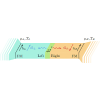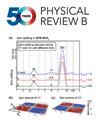驱动合成反铁磁体中纠缠磁子对的产生
IF 3.7
2区 物理与天体物理
Q1 Physics and Astronomy
引用次数: 0
摘要
了解、操纵和利用磁子--自旋波的量子--实现节能应用是磁子学的主要目标之一。在本文中,我们考虑了一种合成反铁磁体,其中一个铁磁层由自旋轨道力矩驱动。我们发现,在自旋轨道力矩和磁场大小的特定条件下,磁子对通过量子波动自发产生,其方式类似于黑洞地平线附近的霍金对产生。其中一个磁子在合成反铁磁体的一个磁层中与间隔层的界面附近产生,而另一个磁子则在另一个磁层中产生。我们计算了这些自发产生的磁子对所产生的磁子电流,并估算了它们在低于该温度时的可观测温度。此外,我们还发现这些磁子是纠缠的,这使得它们在未来的量子磁学应用中非常有趣。本文章由计算机程序翻译,如有差异,请以英文原文为准。

Entangled magnon-pair generation in a driven synthetic antiferromagnet
Understanding, manipulating, and using magnons—the quanta of spin waves—for energy-efficient applications is one of the primary goals of magnonics. In this paper, we consider a synthetic antiferromagnet in which one of the ferromagnetic layers is driven by spin-orbit torque. We find that under specific conditions for the magnitude of the spin-orbit torque and field, magnon pairs are spontaneously produced by quantum fluctuations in a way that is similar to Hawking pair production near black-hole horizons. One of the magnons is generated near the interface with the spacer layer in one of the magnetic layers of the synthetic antiferromagnet, while the other magnon is produced in the other magnetic layer. We compute the magnon current due to these spontaneously generated magnon pairs and estimate the temperature below which they should become observable. Additionally, we find that the magnons are entangled, which makes them interesting for future applications in quantum magnonics.
求助全文
通过发布文献求助,成功后即可免费获取论文全文。
去求助
来源期刊

Physical Review B
物理-物理:凝聚态物理
CiteScore
6.70
自引率
32.40%
发文量
0
审稿时长
3.0 months
期刊介绍:
Physical Review B (PRB) is the world’s largest dedicated physics journal, publishing approximately 100 new, high-quality papers each week. The most highly cited journal in condensed matter physics, PRB provides outstanding depth and breadth of coverage, combined with unrivaled context and background for ongoing research by scientists worldwide.
PRB covers the full range of condensed matter, materials physics, and related subfields, including:
-Structure and phase transitions
-Ferroelectrics and multiferroics
-Disordered systems and alloys
-Magnetism
-Superconductivity
-Electronic structure, photonics, and metamaterials
-Semiconductors and mesoscopic systems
-Surfaces, nanoscience, and two-dimensional materials
-Topological states of matter
 求助内容:
求助内容: 应助结果提醒方式:
应助结果提醒方式:


